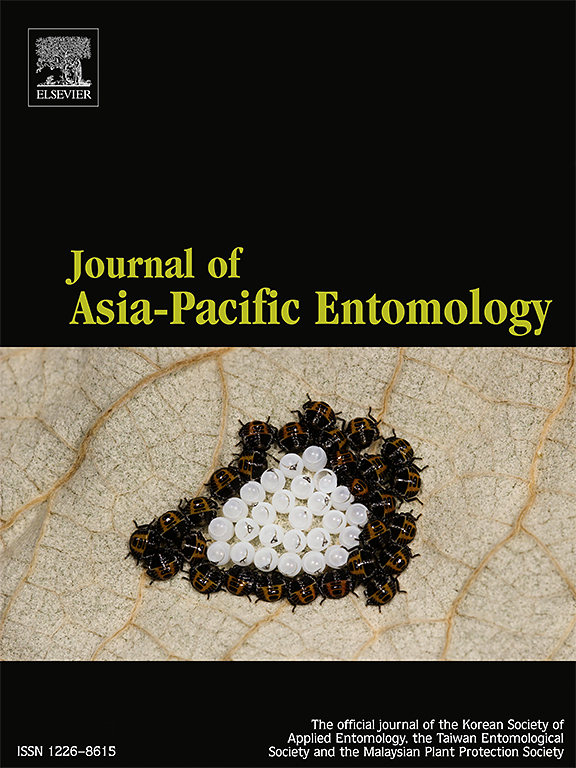颜色对灰蝗摄食偏好的影响(直翅目:蝗科)
IF 1.3
3区 农林科学
Q3 ENTOMOLOGY
引用次数: 0
摘要
许多植物的嫩叶呈现红色或紫色。有人提出,红色/紫色是一种警告信号,表明对食草动物的防御化学物质高度集中在年轻的组织中。特别是,预计通才食草动物不会喜欢红色/紫色的叶子,因为幼叶形成的化学防御通常对通才食草动物比专才食草动物毒性更大或营养更少。为了验证这一假设,研究人员在白光、蓝光和黑暗三种光照条件下,用浸渍了喂食刺激物的彩色纸盘评估了多才多艺的蚱蜢(Acrida cinerea)对颜色的选择。只有在白光下,灰蚜吃的红纸比绿纸少,黄纸比绿纸多。他们吃蓝纸和绿纸,表明他们不认为只有绿色的东西是食物。这些发现支持了灰蚜不喜欢红色食物可能不仅仅是因为红色与树叶的典型颜色不同,而是因为红色是一种警告信号。本文章由计算机程序翻译,如有差异,请以英文原文为准。

Effect of color on the feeding preference of a generalist grasshopper, Acrida cinerea (Orthoptera: Acrididae)
The young leaves of many plant species exhibit red or purple coloration. It has been proposed that the red/purple coloration serves as a warning signal, indicating that defense chemicals against herbivores are highly concentrated in young tissues. In particular, it is expected that generalist herbivores will not like red/purple leaves because the chemical defenses developed by young leaves are generally more toxic or less nutritious to generalist herbivores than to specialists. To test this hypothesis, the color choices made by a generalist grasshopper, Acrida cinerea, were assessed using colored paper discs impregnated with feeding stimulants under three light conditions: white light, blue light, and darkness. Only under white light did A. cinerea eat less red paper and more yellow paper than green paper. They ate blue paper as well as green paper, indicating that they do not consider only green items to be food. These findings support that A. cinerea likely dislikes red foods not simply because red is different from the typical color of leaves but rather because red is a warning signal.
求助全文
通过发布文献求助,成功后即可免费获取论文全文。
去求助
来源期刊

Journal of Asia-pacific Entomology
Agricultural and Biological Sciences-Insect Science
CiteScore
2.70
自引率
6.70%
发文量
152
审稿时长
69 days
期刊介绍:
The journal publishes original research papers, review articles and short communications in the basic and applied area concerning insects, mites or other arthropods and nematodes of economic importance in agriculture, forestry, industry, human and animal health, and natural resource and environment management, and is the official journal of the Korean Society of Applied Entomology and the Taiwan Entomological Society.
 求助内容:
求助内容: 应助结果提醒方式:
应助结果提醒方式:


